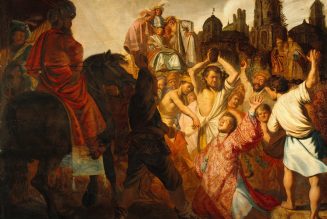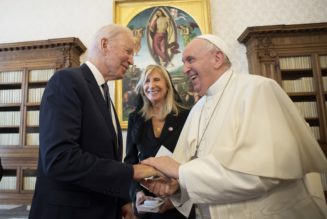
In 2018, the scandal involving then-Cardinal Theodore McCarrick shocked the Catholic world.
McCarrick had a global presence; he operated at the highest levels of the Church, and he enjoyed the highest esteem—both among Catholics and more broadly. But then it was revealed that he had been grooming and sexually abusing young men for decades.
It was yet another heart-wrenching wake-up call for a Church in need of reform, coming after earlier scandals of Church leaders who failed to protect the faithful from predators in her midst.
Despite a slew of meetings, documents, and reforms from bishops on protecting minors and vulnerable adults, Catholics watched as the scandal deepened, and as pews continued to empty, costing souls. It became abundantly clear that the Church’s internal reform needed every hand to the pumps.
In turn, a group of Catholics explored ways in which the laity might better assist bishops to identify healthy environments for priests and models to allow parishes and dioceses to flourish, while helping to spot dangers that could lead to more scandal and heartache for the Church down the line.
The purpose was simple: to love the Church and to help the Church to be holy, with every tool she could be given. And of all the means the Church has employed to help herself, addressing the role of technology was a glaring omission, particularly given that Pope Francis has called for the use of technology for the common good.
Based on that insight, a group was formed, Catholic Laity and Clergy for Renewal (CLCR), to explore ways technology might serve the bishops in addressing their greatest challenges. I’ve been proud to be a part of that group.
After all, data is used by all major corporations, so why not the Church? Perhaps data could be used to gain insight into the life of the Church, such as what sorts of church activities draw people to a parish, or even when and how liturgies are scheduled.
Indeed, this was the case. Catholic Laity and Clergy for Renewal has used data to identify models of parish and diocesan life that flourish, as well as those that were less successful.
We learned, for example, that when seminarians spend a year fasting from technology at the beginning of their studies, the Church is able to discern better and faster if they have a vocation—and those that continue are much more likely to be ordained.
We’ve also conducted studies on why Catholics leave the Church, looked at the ways Catholics engage across social media, surveyed parishioners about their liturgical lives and needs, and worked to develop plans for spiritual formation in seminaries in line with Vatican guidelines. And we’ve put all of this at the service of the Church.
“The Church” is not the laity, or the clergy, or the bishops, or the Vatican, or the myriad of institutions built to support its mission. The Church is all of those things and people in communion, working together, each in its proper place and order.
To that end, everything we’ve tried to do as Catholic Laity and Clergy for Renewal has been collaborative. We’ve met with and brought together pastors, bishops, diocesan officials, academics, and experts to explore issues, evaluate what we can understand, and discuss new ideas and options.
There is always a risk that efforts toward renewal can become about optics, egos, and agendas—just another act in the lobbying circus encamped around our public institutions and life. And the best way to avoid that, I’ve found, is to put everything at the disposal of the bishops, to treat any work we do as a service, freely offered and freely given, for them to use in the best ways they see fit.
That includes what we’ve learned about the darker side of technology.
All of us know that limitless connectivity, and boundless access to information and content, can become an instrument of sinfulness, just as easily as it can help build up our society.
Trafficking in obscene content, and even criminal content, is a risk to the Church and her children, as it is to the rest of society—indeed, as repeated scandals have shown, the danger is more acute because of the Church’s privileged position as the guardian of souls and the door of salvation.
When we learned legal ways to understand risks to the health of the Church beset by technology—including the use of hookup apps by clerics—we studied that. We learned some things. And we shared what we learned directly with bishops—without setting any expectations, we made information available to the leaders of the Church.
Part of our work, we’ve now learned, has come to the attention of the Washington Post—not traditionally an outlet with much regard for the Church, or understanding of how she works and what she teaches. To them, it seems, lay Catholics working with clergy, one at the service of the other, is something sinister, and only understandable through a secular political lens and the narrative of a culture war.
As they and similar secular outlets usually do when trying to talk about Catholic issues, the Post has fixated on a small part of what we do—anything that touches on sex. According to them, it seems, you can (even should) have all the sex you like, with whomever and however you wish, but discussing what the effects of this might be for our physical and mental health—to say nothing of spiritual well-being—is somehow weird and obsessive.
I disagree, and so does the Church. Ignoring the importance and reality of human sexuality and its expression isn’t healthy, and pretending problems aren’t there only stores up worse trouble for everyone, as we have all too painfully learned.
It’s true, as part of our data analysis work, we learned that some clergy were publicly advertising their interest in actions that contradicted their promises of celibacy. Sadly, in some places, we could scarcely avoid seeing it. And there have been news reports about priests arrested for criminal use of such apps. All of that is a problem—one we as a Church can choose to acknowledge and confront, or not.
Publicly available data, bought in the ordinary way, was given to us at CLCR, and as we analyzed it, it became clear that heterosexual and homosexual hookup apps were used by some seminarians and some priests in some places, and with volumes and patterns suggesting those were not isolated moral lapses by individuals.
It should be noted that these sorts of hookup apps are designed specifically for casual, anonymous sexual encounters—it’s not about straight or gay priests and seminarians, it’s about behavior that harms everyone involved, at some level and in some way, and is a witness against the ministry of the Church.
Knowing all this, and understanding what the data showed, I met with a handful of rectors and bishops, telling them what we’d learned and leaving them to act as they discerned best. At no time did I make information available for public use. That, to me, isn’t a work of service to the Church. Rather, I left it to the proper authority of rectors and bishops to act prudentially.
Of course, if we were going to be of genuine help to the Church, we had to do so within the boundaries of the law, including law on data and privacy. And we were meticulous to ensure that we were doing things by the book. We developed policies, such as mandatory reporting to law enforcement should we discover any illegality, like abuse of minors. Thankfully, we did not discover any such cases.
We hoped to keep this work private, so as to be able to have honest and frank conversations with Church leaders, and protect the privacy of those affected.
The Washington Post, it seems, has a different view. To them, discussions about sex and celibacy, sin and salvation, are just fodder for clicks and titillation for readers. Collaborative intent and pastoral discernment are, to professionals in partisan politics, sinister and secretive. We see things differently.
Our work has always been a labor of love, and a work of service, practical and spiritual. It’s a blessing to be able to offer constructive help on issues like parish life, formation, and Church administration. And even the more difficult areas of those conversations have been an impetus for us at Catholic Laity and Clergy for Renewal to pray and fast with and for our priests.
All any Catholic of goodwill wants is a strong and thriving Church, for the good of souls and at the service of our society.
In spite of whatever hostility it may meet from others, I’ve no intention of shying away from helping where I can, and serving where we can be of service. A healthy Church needs thriving Catholic communities. And yes, those communities need faithful and joyful pastors, so it is incumbent on all of us to do what we can, to help bishops to care for their clergy, and to help priests to take care of their own spiritual, emotional, and physical health.
The Church desperately needs holy priests; may all of us help our priests live out their vocations faithfully. Mary, Mother of Priests, pray for us and all priests.
Jayd Henricks is the president of Catholic Laity and Clergy for Renewal. He served at the U.S. Conference of Catholic Bishops for eleven years and holds a STL in systematic theology from the Dominican House of Studies.
First Things depends on its subscribers and supporters. Join the conversation and make a contribution today.
Click here to make a donation.
Click here to subscribe to First Things.
![[Must-read article for dads and priests] Will the men “break” or will they lead? The historic opportunity of COVID-19…..](https://salvationprosperity.net/wp-content/uploads/2020/09/must-read-article-for-dads-and-priests-will-the-men-break-or-will-they-lead-the-historic-opportunity-of-covid-19-327x219.jpg)







